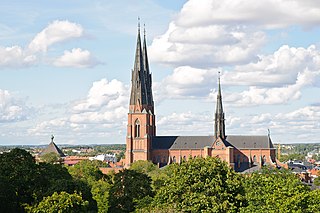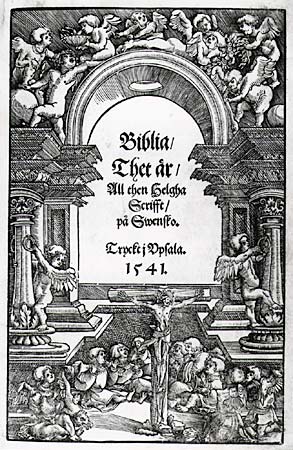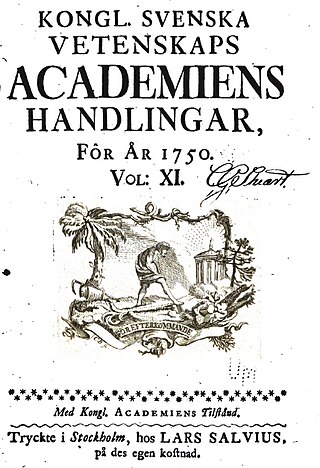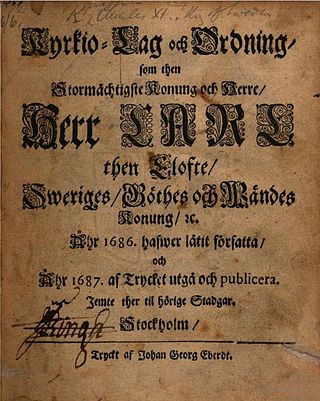| Years in Sweden: | 1683 1684 1685 1686 1687 1688 1689 |
| Centuries: | 16th century · 17th century · 18th century |
| Decades: | 1650s 1660s 1670s 1680s 1690s 1700s 1710s |
| Years: | 1683 1684 1685 1686 1687 1688 1689 |

Events from the year 1686 in Sweden
| Years in Sweden: | 1683 1684 1685 1686 1687 1688 1689 |
| Centuries: | 16th century · 17th century · 18th century |
| Decades: | 1650s 1660s 1670s 1680s 1690s 1700s 1710s |
| Years: | 1683 1684 1685 1686 1687 1688 1689 |

Events from the year 1686 in Sweden
| | This section needs expansion. You can help by adding to it. (June 2015) |

The Church of Sweden is an Evangelical Lutheran national church in Sweden. A former state church, headquartered in Uppsala, with around 5.6 million members at year end 2021, it is the largest Christian denomination in Sweden, the largest Lutheran denomination in Europe and the third-largest in the world, after the Ethiopian Evangelical Church Mekane Yesus and the Evangelical Lutheran Church in Tanzania.

The Evangelical Lutheran Church of Finland is a national church of Finland. It is part of the Lutheran branch of Christianity. The church has a legal position as a national church in the country, along with the Orthodox Church of Finland.

The Catholic Church in Sweden was established by Archbishop Ansgar in Birka in 829, and further developed by the Christianization of Sweden in the 9th century. King Olof Skötkonung is considered the first Christian king of Sweden.

The Torsåker witch trials took place in 1675 in Torsåker parish in Sweden and were the largest witch trials in Swedish history. In a single day 71 people were beheaded and then burned.
The legal status of same-sex marriage has changed in recent years in numerous jurisdictions around the world. The current trends and consensus of political authorities and religions throughout the world are summarized in this article.
Same-sex marriage has been legal in Sweden since 1 May 2009 following the adoption of a gender-neutral marriage law by the Riksdag on 1 April 2009. Sweden was the seventh country in the world to open marriage to same-sex couples nationwide. Existing registered partnerships remain in force and can be converted to a marriage if the partners so desire, either through a written application or through a formal ceremony. New registered partnerships are no longer able to be entered into and marriage is now the only legally recognized form of union for couples regardless of sex.

Religion in Sweden has, over the years, become increasingly diverse. Christianity was the religion of virtually all of the Swedish population from the 12th to the early 20th century, but it has rapidly declined throughout the late 20th and early 21st century.
The Swedish Church Ordinance of 1571 was the first complete Swedish church order following the Swedish Reformation in the 1520s.

The Reformation in Sweden is generally regarded as having begun in 1527 during the reign of King Gustav I of Sweden, but the process was slow and did not end definitively until the Uppsala Synod of 1593 and the following War against Sigismund, with an attempted counter-reformation during the reign of John III (1568–1592).

Socken is the name used for a part of a county in Sweden. In Denmark similar areas are known as sogn, in Norway sokn or sogn and in Finland pitäjä(socken). A socken is a country-side area that was formed around a church, typically in the Middle Ages. A socken originally served as a parish. Later it also served as a civil parish or an administrative parish, and became a predecessor to today's municipalities of Sweden, Finland, Norway and Denmark. Today it is a traditional area with frozen borders, in Sweden typically identical to those of the early 20th century country-side parishes. The socken also served as a registration unit for buildings, in Sweden recently replaced by identical districts as registration unit. A socken consists of several villages and industry localities, and is typically named after the main village and the original church.

The status and rights of Women in Sweden has changed several times throughout the history of Sweden. These changes have been affected by the culture, religion and laws of Sweden, as well as social discourses like the strong feminist movement.
Widow conservation was a practice in Protestant Europe in the early modern age, when the widow of a parish vicar would marry her husband's successor to the vicarage to ensure her economic support. The practice was common in Scandinavia (Änkekonservering/Enkekonservering) and Protestant parts of Germany. It is related to other forms of widow inheritance, including the levirate marriage known in the Old Testament as yibbum.

Events from the year 1862 in Sweden

Events from the year 1739 in Sweden

Events from the year 1571 in Sweden

The Swedish Church Law 1686 was a Swedish law which regulated the relationship between the state and the church in Sweden from 1686 until the Swedish Church Law 1992, as well as in Finland until 1870. It replaced the previous Swedish Church Ordinance 1571.
Brechtgien "Birgitta" Durell, née von Crakow or von Cracauw was a Swedish industrialist.
1720 års skråordning was a law reform introduced in Sweden in 1720. It replaced the 1669 års allmänna skråordning and, with additional modifications, regulated the guild system and business life in Sweden until the Fabriks och Handtwerksordning and Handelsordningen of 1846.
Timeline of women's legal rights (other than voting) represents formal changes and reforms regarding women's rights. That includes actual law reforms as well as other formal changes, such as reforms through new interpretations of laws by precedents. The right to vote is exempted from the timeline: for that right, see Timeline of women's suffrage. The timeline excludes ideological changes and events within feminism and antifeminism: for that, see Timeline of feminism.

Sweden was a country with few witch trials compared to other countries in Europe. In Sweden, about four hundred people were executed for witchcraft prior to the last case in 1704. Most of these cases occurred during a short but intense period; the eight years between 1668 and 1676, when the witch hysteria called det stora oväsendet took place, causing a large number of witch trials in the country. It is this infamous period of intensive witch hunt that is most well known and explored and given attention.